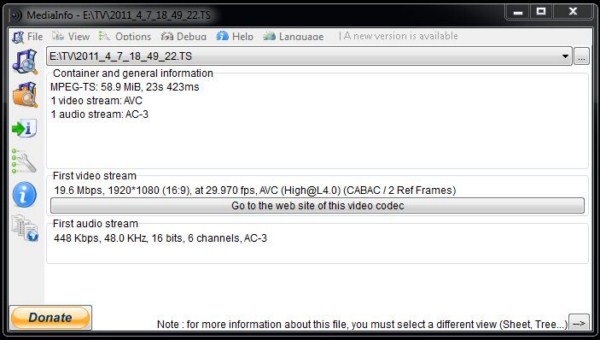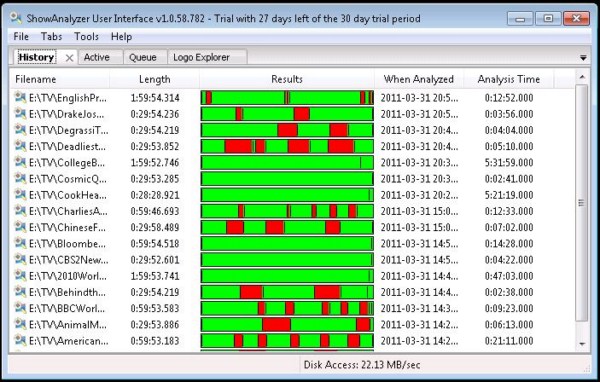Hauppauge Colossus: HD PVR with HDMI Support
by Andrew Van Til on April 14, 2011 5:40 PM EST- Posted in
- HTPC
- Home Theater
- Hauppauge
Testing and Evaluation
With an original HD PVR and Ceton InfiniTV 4 Digital Cable Tuner (DCT) on hand, it provided us with the opportunity to record the same content using MediaInfo and perform visual inspections to document differences in quality. For the results above, the Colossus and HD PVR were configured in-line using the YPbPr/TOSLINK pass-through from the STB. They were set to use the highest recording profile in SageTV, with SageDCT used to capture the raw TS stream from the InfiniTV 4 as a reference point. The settings used by the various devices are summarized in the following table.
| Device Recording Profile Summary | |||
| Video Resolution | Colossus | HD PVR | SageDCT (RAW) |
| 480i | 3985 Kbps 720x480@29.97 AVC (Main@L3.2) (CABAC/2 Ref Frames) | 4695 Kbps 720x480@29.97 AVC (Main@L3.1) (CABAC/4 Ref Frames) | 2948 Kbps 528x480@29.97 MPEG2 (Main@Main) |
| 720p | 7924 Kbps 1280x720p@59.94 AVC (High@L4.0) (CABAC/2 Ref Frames) | 11.8 Mbps 1280x720@59.94 AVC (Main@4.0) (CABAC/4 Ref Frames) | 10.5 Mbps 1280x720@59.94 MPEG2 (Main@High) |
| 1080i | 12.7Mbps 1920x1080i@29.97 AVC (High@L4.0) (CABAC/2 Ref Frames) | 11.7Mbps 1920x1080i@29.97 AVC (High@L4.0) (CABAC/4 Ref Frames) | 16.5 Mbps 1920x1080@29.97 MPEG2 (Main@High) |
There are differences in the bitrate and AVC profiles used by the two Hauppauge devices; the Colossus uses a higher rate for 1080i and the HD PVR uses higher bitrates for 720p and 480i. The InfiniTV 4 was a third set of values. With three points of reference and digital source content, there is little noticeable difference between the captured files in real terms. (If you’re interested in seeing clips of the videos, let us know and we’ll see about including download links.
Alongside the comparative testing, the Colossus was also evaluated for the overall quality and “watchability” of recordings captured at native resolution from the STB. We recorded sixty files with a 33% distribution per resolution at random intervals and channels, and then sampled at five to ten points in each file for issues related to audio and video. We looked for A/V synchronization problems, stutter, and dropouts, and the final result is an 8.33% fail rate. Most of the “fail” issues only occurred in specific locations in the files, and while annoying they were not severe enough to abandon playback. However, there were also entire recordings with no audio or significant enough issues with audio drops or video playback that continued viewing was very unpleasant or impossible.

Before moving on it is interesting to note that the maximum bitrate available in ShowBiz and via the encoder’s property page (shown below) is quite a bit higher (~20Mbps) than what is used by SageTV when selecting the best rate (~14 Mbps). It is unlikely that the value of encoding at this high a level would result in a great enough pay off to justify the increased file size given the bitrate of most TV content, but it is good to know that it is possible if the content warrants it.
Additional Testing
I love it when my interests in the HTPC space overlap, so having observed the difference in bitrate capabilities and issues with file capture it provided an easy excuse to start writing code against the Colossus and figure out how to drive the device. For anyone who has done any playing with DirectShow, the following screenshot of the capture graph in GraphStudio should be very familiar. It demonstrates the four components necessary to enable file capture from the device with the property pages for the “Capture” and “Encoder” filters (which are what ShowBiz exposes through its GUI) displayed. The file sink—the component at the end that writes the TS packets to disk as they are output from the encoder (in this case a slightly customized version of the “Dump” sample included in the Windows SDK)—is the only filter not provided by the drivers.

Using that as a starting point I wrote a simple application to prototype input selection (it supports component + S/PDIF or HDMI) and filter configuration. Using standard DirectShow interfaces, I was able to reproduce both the capture issues and the inconsistent bitrate values observed with ShowBiz and SageTV, where after setting the device to the maximum bitrate (~20Mbps) through the encoder interface it actually uses ~14Mbps. I have asked Hauppauge to provide documentation for programming against the device in case there is a different, non-obvious, mechanism for configuring the card, but they did not provide it in time for this review. For anyone interested in looking at the source code for the application it is available here.

Anyone who made the jump to the original HD PVR when it was released will remember that the commercial scanning story was a bit troubled. Fortunately, the work that was done to support the AVC TS files created with it carries over to those generated using the Colossus. Applications like ShowAnalyzer are able to scan the files and detect commercials in them.










60 Comments
View All Comments
Anthony Toste - Friday, April 15, 2011 - link
Frist your cable need be copy-freely flags good luck that not going to last long and MCE is use less any way with all DRM junk it has."extender functionality, you're willing to use an Xbox 360"
Don't you still have buy the Membership for that work beside there no PC MCE Client that why SageTV Rule's and SageTV Extender Rules for NoN Console user.
babgvant - Friday, April 15, 2011 - link
I don't agree with that. Ceton got Cable Labs to clarify/change the rules on Copy Freely content specifically to enable that scenario. Obviously they know about the use case, and opted to do the right thing for end users (I know it's strange :)).Anthony Toste - Friday, April 15, 2011 - link
Your forget that it not up to Cable Labs it the Studio and some of the Distributed that got the rigths to shows or moive that have the final say so.babgvant - Friday, April 15, 2011 - link
Cable Labs owns the DRI specification; content producers have a say, but only cursorily - currently it is up to the Cable company to mark/not mark content.It would be one thing to exploit a loop hole but the use case is known, and has an explicit OK from Cable Labs. I don't see how you (or anyone) can make statements like "good luck that not going to last long".
glugglug - Friday, April 15, 2011 - link
There's no membership needed for using an XBOX as an extender. And the DRM won't limit your extender use. The Ceton with MCE really is by far the best option out there.babgvant - Wednesday, April 20, 2011 - link
The 360 is a good extender device for TV based content, but once you move beyond that its support for other formats (DVD, BD, MKV, etc.) is very limited.glugglug - Friday, April 15, 2011 - link
Actually, FIOS is even better for it than cable for most CableCARDS. Unlike TWC, they don't require a truck roll to deliver the cablecard (you can pick it up at a payment center), nothing but premium channels ends up with DRM in the recordings, and in most areas the CableCARD from FIOS doesn't even need to be paired, so you can move it between devices without a phone call.jonp - Tuesday, April 19, 2011 - link
I think your point on cablecard is well taken. Since all HD content on cable requires a cablecard (I think--yes?), what good is a tuner without cablecard capability for the 60% or so of TVs connected to cable?Macoy - Thursday, April 14, 2011 - link
Can this do streaming captures? I used to have a K-World SD tv tuner, and I would be able to select it in my ustream flash options, and stream it live.babgvant - Thursday, April 14, 2011 - link
Can you explain this use case a bit more? I'm leaning towards "no"; the device only takes external input AFAIK it does not expose the capture filter for internal input.